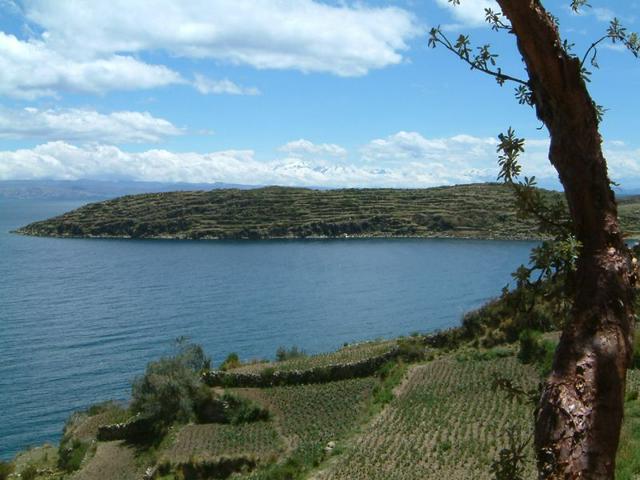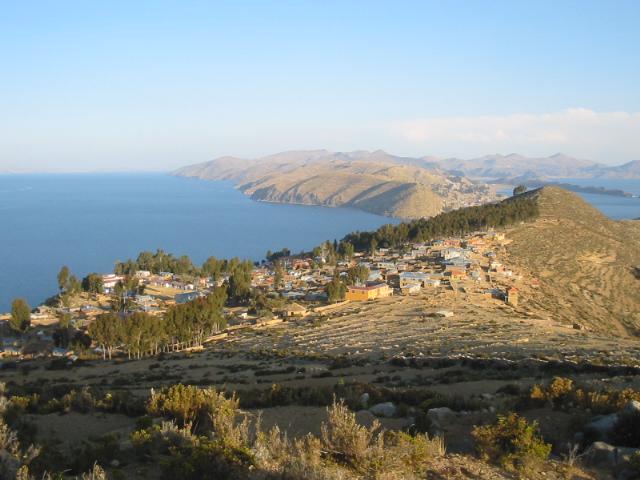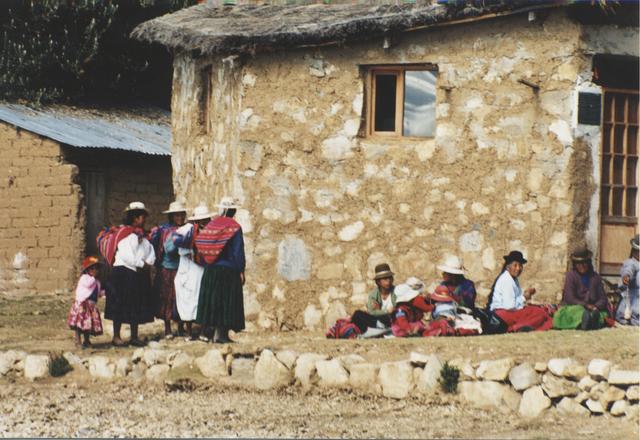Isla del Sol ("Island of the Sun") is the largest island on Lake Titicaca, and part of Bolivian territory. An ancient holy site of the Inca, it's easily reachable from Copacabana.



- Challapampa. - A village near the north end of Isla del Sol in Lake Titicaca, Bolivia. It has a quite basic tourist infrastructure.
- Yumani. - Has the best infrastructure on the island, and is where mostly people choose to stay overnight.
Challapampa. - A village near the north end of Isla del Sol in Lake Titicaca, Bolivia. It has a quite basic tourist infrastructure.
Yumani. - Has the best infrastructure on the island, and is where mostly people choose to stay overnight.
Inca legend says that Viracocha, the bearded god who created the universe, emerged from the waters of Lake Titicaca and created the sun at this location.
The son and daughter of Inti were sent out of one of the caves on the island with a golden staff. Manco Cápac took this staff across the water and found Cusco between the mountains. He decided to start his Inca empire there. This of course is according to legend. In reality, Cápac probably lived in the region of Cusco instead.
As of 2019, the central and northern portions of the island remain closed to tourists due to an ongoing dispute between the communities of Cha'llapampa, located at the north end of the island, and Cha’lla, located in the center. No tourist boats are permitted to come ashore in Cha'llapampa and overland visitors are turned back at the checkpoint.. As a result, many of the interesting sites such as the Gold Museum, Rock of the Puma, Inca Table, and Footsteps of the Sun are inaccessible.
The dispute originated in early 2017 when tourism huts were built near an archaeological site on the north end of the island. After concerns their proximity jeopardized the preservation of the site were ignored, inhabitants of Cha'llapampa destroyed the buildings. Cha’lla responded by blockading access to Cha'llapampa by both land and water.
The dispute has been, at times, violent, resulting in injuries among local residents and burned boats. In 2018, foreign tourists attempting to dock in Cha'llapampa were attacked and detained until the Navy intervened and returned them to Copacabana.
Each passenger entering the island has to pay Bs. 10 when leaving the boat.
Unless you're spending the night on the island, your itinerary will be basically determined by the boat tour you arrived on. Frankly, the half-day tour is barely worthwhile as it consists only of a brief stop at the southern end and most of your time will be spent on the boat.
A full-day tour will take two hours to get from Copacabana to Cha'llapampa, two and a half hours to see the museum and make a round trip hike to the Rock of the Puma, three hours to take the boat to Isla de la Luna and back to the Inca Steps at the town of Yumani, and two hours for the ride back to Copacabana. You can also choose to hike from the Rock of the Puma back to Yumani (three hours) and catch the boat from there. (Decide on this when buying tickets, as the boat fare to Isla de la Luna adds just a bit to the cost.)
- Cha'llapampa, the town on the northern end of the island, is where the boat lets you off. The Gold Museum (Museo de Oro) displays Inca treasures which were discovered underwater off the island in the last decade. The Bs. 5 admission also lets you see the Rock of the Puma. Other than that, the town has a small beach and some dirt roads.
- The sights on the northern tip are ancient Inca sacred sites. The Rock of the Puma, or Titi Kharka, after which the lake is named, is a large formation that will probably look nothing like a puma until the guide points it out. Your reaction will likely either be "Ah, there it is!" or "That's it?!" A short distance from the rock is the Inca Table, a low platform fashioned of stone. You may just be imagining a red tint on it, but it was supposedly used for human sacrifices. The Footsteps of the Sun nearby are a set of natural (or supernatural?) impressions in rock.
- From Yumani on the southern part of the island, the Inca Steps descend down to the water. At the bottom is the Fountain of Youth. (Oh, those gullible conquistadors!) The channel of water flowing down the hill should convince you that drinking from it is much more likely to shorten your life than extend it.
- The Temple of Pilcocaina is a little further south, and is an optional stop for the boat tour. Bs. 5 admission.
Cha'llapampa, the town on the northern end of the island, is where the boat lets you off. The Gold Museum (Museo de Oro) displays Inca treasures which were discovered underwater off the island in the last decade. The Bs. 5 admission also lets you see the Rock of the Puma. Other than that, the town has a small beach and some dirt roads.
The sights on the northern tip are ancient Inca sacred sites. The Rock of the Puma, or Titi Kharka, after which the lake is named, is a large formation that will probably look nothing like a puma until the guide points it out. Your reaction will likely either be "Ah, there it is!" or "That's it?!" A short distance from the rock is the Inca Table, a low platform fashioned of stone. You may just be imagining a red tint on it, but it was supposedly used for human sacrifices. The Footsteps of the Sun nearby are a set of natural (or supernatural?) impressions in rock.
From Yumani on the southern part of the island, the Inca Steps descend down to the water. At the bottom is the Fountain of Youth. (Oh, those gullible conquistadors!) The channel of water flowing down the hill should convince you that drinking from it is much more likely to shorten your life than extend it.
The Temple of Pilcocaina is a little further south, and is an optional stop for the boat tour. Bs. 5 admission.
Again, Yumani has the best offerings. Challapampa could be good for lunch if you are coming with the morning boat and staying overnight on the island. Many places in Copacabana will sell you a lunch box, convinient for daytrippers. The few shops around have limited stocks -fruits are mostly bananas and apples. Many eateries charge about Bs. 30 for a dinner.
- Las Velas, Yumani, Isla del Sol, Bolivia (Follow the signs through the Eucalyptus trees at the top of the Inca Stairs, +591 712 356616. Hard to find but worth the walk. Serves trout, filet mignon and the excellent vegetarian pizza. The food doesn't get made until it's ordered, so have a few drinks while you wait. There is no electricity so the place is candle lit in the evening. Amazing sunsets from here as well. The owner will walk you back to the main area of Yumani by flashlight if needed. Bs. 30-50 pp (without drinks).
Yumani is growing fast and already has a lot of tourist facilities. There are some basic alojamientos in Challapampa and Challa. Challapampa in the northern part is much easier to get to, the village is on the beach and the to accommodation are cheaper. The cheapest hospedajes start at about US$2 per night. At those prices expect basic conditions, everything is pretty clean and decent though. Camping should be possible in Challapampa.
Las Velas, Yumani, Isla del Sol, Bolivia (Follow the signs through the Eucalyptus trees at the top of the Inca Stairs, +591 712 356616. Hard to find but worth the walk. Serves trout, filet mignon and the excellent vegetarian pizza. The food doesn't get made until it's ordered, so have a few drinks while you wait. There is no electricity so the place is candle lit in the evening. Amazing sunsets from here as well. The owner will walk you back to the main area of Yumani by flashlight if needed. Bs. 30-50 pp (without drinks).
Isla del Sol might be a nice destination, if you have never seen an island in a lake, like in Greece. However, considering the number of tourists shoved in here every day, the locals demanding Bs. 10 from each and watching the tourist arrive, as well as the numerous pizzerias on the island leave doubts about the authenticity of this place. Yes, it is quiet and nice. But is it really worth the trip? Maybe Copacabana, its hills and its trails are already sufficient enough to get a feeling for the area and lay back.
- Isla de la Luna is easiest visited from Yumani, by renting a boat. However, regular tours and boats also go to the island.
